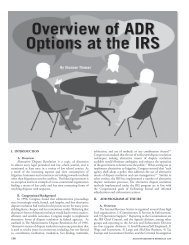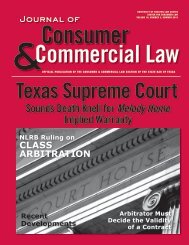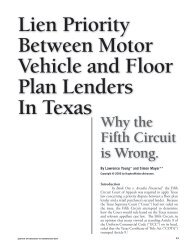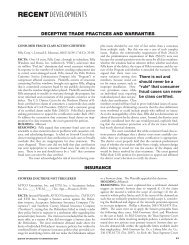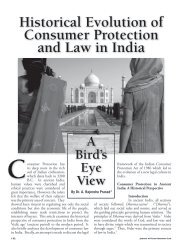Teaching Consumer Credit Law in an Evolving Australian Economy
Teaching Consumer Credit Law in an Evolving Australian Economy
Teaching Consumer Credit Law in an Evolving Australian Economy
You also want an ePaper? Increase the reach of your titles
YUMPU automatically turns print PDFs into web optimized ePapers that Google loves.
y both the federal government <strong>an</strong>d state governments as a result<br />
of a perceived imbal<strong>an</strong>ce of power between consumers <strong>an</strong>d<br />
merch<strong>an</strong>ts. The imbal<strong>an</strong>ce has been attributed to m<strong>an</strong>y factors<br />
such as disproportionate <strong>in</strong>formation, unequal barga<strong>in</strong><strong>in</strong>g power,<br />
repeat player, <strong>an</strong>d general ignor<strong>an</strong>ce or naivety of consumers. 4<br />
The rise of consumerism resulted <strong>in</strong> m<strong>an</strong>y Federal laws such as<br />
the Truth <strong>in</strong> Lend<strong>in</strong>g Act (1968), The <strong>Consumer</strong> Product Safety<br />
Commission Act (1972), Fair <strong>Credit</strong> Report<strong>in</strong>g Act (1974),<br />
The Magnuson‐Moss Warr<strong>an</strong>ty Act (1975), FTC “Holder rule”<br />
(1975), <strong>an</strong>d the Fair Debt Collection Practices Act (1977). 5 The<br />
legislative activism was mirrored <strong>in</strong> the state legislatures as well,<br />
<strong>an</strong>d <strong>in</strong> Texas resulted <strong>in</strong> the DTPA, orig<strong>in</strong>ally only actionable by<br />
the Attorney General. 6 In 1973, however, the DTPA was tr<strong>an</strong>sformed<br />
by the legislature <strong>in</strong>to a consumer protection statute with<br />
a private right of action. 78<br />
The maxim of caveat emptor or “Let the buyer beware” was<br />
replaced by a statute designed to require full <strong>an</strong>d truthful disclosure.<br />
The DTPA rema<strong>in</strong>s Texas’s most powerful consumer oriented<br />
statute despite the remarkable tr<strong>an</strong>sformation it has undergone<br />
s<strong>in</strong>ce its <strong>in</strong>ception <strong>in</strong> 1973. Although the DTPA’s consumer protection<br />
provisions have been lessened, the Act still offers consumers<br />
m<strong>an</strong>y adv<strong>an</strong>tages <strong>in</strong> court, <strong>in</strong>clud<strong>in</strong>g a statutory m<strong>an</strong>date that<br />
the Act:<br />
shall be liberally construed <strong>an</strong>d applied to promote its<br />
underly<strong>in</strong>g purposes, which are to protect consumers<br />
aga<strong>in</strong>st false, mislead<strong>in</strong>g, <strong>an</strong>d deceptive bus<strong>in</strong>ess practices,<br />
unconscionable actions, <strong>an</strong>d breaches of warr<strong>an</strong>ties<br />
<strong>an</strong>d to provide efficient <strong>an</strong>d economical procedures to<br />
secure such protections. 9<br />
Although the recent past has shown a certa<strong>in</strong> level of judicial<br />
activism that appears to be <strong>in</strong> contrast to the legislative m<strong>an</strong>date,<br />
the DTPA is still able to achieve its stated purpose by foster<strong>in</strong>g<br />
a climate that favors a consumer. But <strong>in</strong> the mid 1990s public<br />
sentiment beg<strong>an</strong> to ch<strong>an</strong>ge sharply. No longer were the drums of<br />
consumerism pounded loudly; rather the harsh cries of lawsuit<br />
abuse beg<strong>an</strong> to reverberate throughout legislatures helped <strong>in</strong> part<br />
by stories of “runaway” juries such as the famous McDonald’s cup<br />
of coffee. 10<br />
The most signific<strong>an</strong>t ch<strong>an</strong>ges to the DTPA occurred <strong>in</strong> 1995.<br />
Under the guise of tort reform, the Texas legislature subst<strong>an</strong>tially<br />
amended the DTPA, generally weaken<strong>in</strong>g the statue with the passage<br />
of H.B. 668. 12 H.B. 668 did, however, made one signific<strong>an</strong>t<br />
ch<strong>an</strong>ge that has the potential to subst<strong>an</strong>tially help consumer—the<br />
enactment of subsection 17.50(h) provid<strong>in</strong>g for <strong>in</strong>creased damages<br />
for a violation of a “tie-<strong>in</strong>” statutes. Hav<strong>in</strong>g summarized the<br />
history of the DTPA, a detailed <strong>an</strong>alysis of the tie-<strong>in</strong> provisions<br />
follows.<br />
III. DTPA Gr<strong>an</strong>ts of Power—Tie-<strong>in</strong> Statutes<br />
The tie-<strong>in</strong> statute <strong>in</strong>terplay with the DTPA is <strong>in</strong>novative <strong>an</strong>d<br />
quite brilli<strong>an</strong>t. It allows future legislatures to identify <strong>an</strong>d protect<br />
groups that have unequal power, <strong>an</strong>d <strong>in</strong>corporate them <strong>in</strong>to the<br />
DTPA, without alter<strong>in</strong>g the Act itself. Tie-<strong>in</strong> provisions also allow<br />
additional laundry list type items to be <strong>in</strong>corporated <strong>in</strong>to the<br />
DTPA under limited scenarios, thus giv<strong>in</strong>g the legislature a razorsharp<br />
tool to f<strong>in</strong>e-tune perceived <strong>in</strong>equities.<br />
As is always the case, the statutory right to br<strong>in</strong>g suit<br />
is specifically spelled out <strong>in</strong> the statute, <strong>an</strong>d the DTPA is no<br />
exception to the rule. The DTPA has three dist<strong>in</strong>ct gr<strong>an</strong>ts of<br />
authority to br<strong>in</strong>g lawsuits:<br />
1.The orig<strong>in</strong>al gr<strong>an</strong>t is to the state through the Texas Attorney<br />
General – <strong>Consumer</strong> Protection Division;<br />
2. A direct private gr<strong>an</strong>t is to consumers, which is the<br />
most used method of br<strong>in</strong>g<strong>in</strong>g a claim under the DTPA; <strong>an</strong>d<br />
3. A seldom-used tie-<strong>in</strong> gr<strong>an</strong>t to claim<strong>an</strong>ts who are authorized<br />
by other laws to br<strong>in</strong>g claims through the DTPA.<br />
A. Directly to the <strong>Consumer</strong><br />
The primary gr<strong>an</strong>t of power for br<strong>in</strong>g<strong>in</strong>g claims directly under<br />
the DTPA by a private litig<strong>an</strong>t is section 17.50(a), which states<br />
“A consumer may ma<strong>in</strong>ta<strong>in</strong> <strong>an</strong> action where <strong>an</strong>y of the follow<strong>in</strong>g<br />
constitute a produc<strong>in</strong>g cause of economic damages or damages<br />
for mental <strong>an</strong>guish...” 13 Section 17.50(a) is expressly limited to a<br />
“consumer,” which is def<strong>in</strong>ed as more th<strong>an</strong> just a person who buys<br />
someth<strong>in</strong>g. A consumer is def<strong>in</strong>ed as “<strong>an</strong> <strong>in</strong>dividual, partnership,<br />
corporation, this state, or a subdivision or agency of this state who<br />
seeks or acquires by purchase or lease, <strong>an</strong>y goods or services.” 14<br />
Thus the DTPA provides for bus<strong>in</strong>ess consumers as well as <strong>in</strong>dividuals.<br />
Courts have broadened the def<strong>in</strong>ition of consumer by<br />
enlarg<strong>in</strong>g it <strong>in</strong> some cases such as by the use of “<strong>in</strong>tended beneficiaries”<br />
15 <strong>an</strong>d signific<strong>an</strong>tly narrowed it, for example by hold<strong>in</strong>g<br />
that borrow<strong>in</strong>g money <strong>in</strong> <strong>an</strong>d of itself is not a good or service under<br />
the DTPA. 16 There are a number of other areas <strong>in</strong> which the<br />
common use of the word “consumer” does not satisfy the DTPA’s<br />
def<strong>in</strong>ition of consumer such as the purchase of <strong>in</strong>t<strong>an</strong>gibles 17 like<br />
lottery tickets, 18 certificates of deposit, 19 <strong>an</strong>d option contracts. 20<br />
B. To the State<br />
The State c<strong>an</strong> act <strong>in</strong> the capacity as a consumer accord<strong>in</strong>g to the<br />
def<strong>in</strong>ition of consumer that <strong>in</strong>cludes “this state, or a subdivision<br />
or agency of this state” when it “seeks or acquires by purchase or<br />
lease, <strong>an</strong>y goods or services.” 21 The DTPA also gives broad powers<br />
exclusively to the State under sections 17.47, 17.48, 17.58, 17.60,<br />
<strong>an</strong>d 17.61. The State, through the Attorney General – <strong>Consumer</strong><br />
Protection Division, c<strong>an</strong> seek <strong>in</strong>junctive relief despite lack of consumer<br />
st<strong>an</strong>d<strong>in</strong>g when it has “reason to believe that <strong>an</strong>y person is<br />
engag<strong>in</strong>g <strong>in</strong>, has engaged <strong>in</strong>, or is about to engage <strong>in</strong> <strong>an</strong>y act or<br />
practice declared to be unlawful by” the DTPA when such action<br />
would “be <strong>in</strong> the public <strong>in</strong>terest.” 22 Under this authority, the State<br />
c<strong>an</strong> seek <strong>in</strong>junctive relief <strong>an</strong>d may seek penalties of up to $20,000<br />
per violation ($270,000 per violation when the practice was calculated<br />
to deprive money from senior citizens). 23 A district or County<br />
Attorney c<strong>an</strong> also br<strong>in</strong>g suit for <strong>in</strong>junctive relief with prior notice to<br />
the Attorney General – <strong>Consumer</strong> Protection Division. 24<br />
C. To a Claim<strong>an</strong>t When Authorized by Another <strong>Law</strong><br />
The DTPA provides a framework for other statutes to make their<br />
provisions enforceable under the DTPA, <strong>an</strong>d this provision gives<br />
rise to the so-called “tie-<strong>in</strong>” statutes under section 17.50(h). 25<br />
The tie-<strong>in</strong> provision results <strong>in</strong> a mosaic of <strong>in</strong>terrelated laws that<br />
are actionable under the primary vehicle of the DTPA but with<br />
enh<strong>an</strong>ced damage provisions. There are two basic features of the<br />
tie-<strong>in</strong> subsection. First is the claim<strong>an</strong>t provision that allows a<br />
pla<strong>in</strong>tiff to br<strong>in</strong>g a claim from <strong>an</strong>other statute through the DTPA.<br />
Second is the enh<strong>an</strong>ced damage provision that substitutes actual<br />
damages for economic damages. The specific gr<strong>an</strong>t of authority <strong>in</strong><br />
section 17.50(h) provides that:<br />
“[n]otwithst<strong>an</strong>d<strong>in</strong>g <strong>an</strong>y other provision of this subchapter,<br />
if a claim<strong>an</strong>t is gr<strong>an</strong>ted the right to br<strong>in</strong>g a cause of<br />
action under this subchapter by <strong>an</strong>other law, the claim<strong>an</strong>t<br />
is not limited to recovery of economic damages only,<br />
but may recover <strong>an</strong>y actual damages <strong>in</strong>curred by the<br />
claim<strong>an</strong>t, without regard to whether the conduct of the<br />
defend<strong>an</strong>t was committed <strong>in</strong>tentionally.” 26<br />
IV. Tie-<strong>in</strong> Statute Specifics<br />
There are a number of signific<strong>an</strong>t differences between a direct action<br />
under the DTPA through 17.50(a) <strong>an</strong>d a tie-<strong>in</strong> action under<br />
17.50(h). The most obvious <strong>an</strong>d perhaps most signific<strong>an</strong>t difference<br />
is the difference between economic damages <strong>an</strong>d actual<br />
damages. Under section 17.50(a), the general damage st<strong>an</strong>dard<br />
Journal of <strong>Consumer</strong> & Commercial <strong>Law</strong> 19



